Summary:
When hearing aid wearers find themselves in situations where they are struggling to understand speech in noise, their first reaction may be to desire more gain in their hearing aids for those situations. But this can be counterproductive. A new study shows how lowering the aided noise floor of the hearing aid output in a controlled manner can result in better preservation of speech loudness when listening to speech in noise.
By Petri Korhonen, MSc (tech); Francis Kuk, PhD; Christopher Slugocki, PhD; Heidi Peeters, MA
When hearing aid wearers find themselves in situations where they are struggling to understand speech in noise, their first reaction may be to desire more gain in their hearing aids for those situations. This can be counterproductive if the target speech and noise are both increased in equal amounts. Widex Allure uses a unique noise reduction approach that accounts for the psychometric principle of partial loudness where sounds are perceived as softer when there is a masking noise present. Paradoxically, hearing aid wearers may report that target sounds are louder when the gain on their hearing aids is lowered by the new Speech Enhancer Pro noise reduction system. The results of this study offer an explanation of why wearers may make such observations.
Loudness in Background Noise
Loudness is the magnitude of auditory sensation [1]. Typically, when we increase the sound pressure level (SPL) of a sound in quiet, listeners report that the sound becomes louder, and when we reduce its level, listeners report that the sound becomes softer. On the other hand, in the presence of a noisy background, the loudness of a target sound (TS) depends not only on the SPL of the TS itself, but also on the levels of the other sounds in the listening environment [2]. Consider someone speaking at a conversational level of 65 dB SPL in a quiet room. This would be perceived as “natural,” “comfortably loud,” and “clearly audible” by most listeners with normal hearing. However, if the same talker was speaking at the same SPL in a noisy room, the listener could perceive them as speaking too softly. For speech to be perceived as equally loud in the noisy room as it does in the quiet room, the talker would have to speak more loudly.
The phenomenon by which the loudness of a TS is reduced by the presence of other sounds is called partial loudness, and it can be described by a masked loudness-matching function such as that shown in Figure 1. The black line shows the level of the TS alone (in quiet) as a function of the level of the TS in noise at the point where the loudness of both would be considered equal. The exact shape of the function is unique to each TS and masking noise type and level. Typically, the masked loudness-matching function shows that the level of the TS needs to be higher in noise than in quiet to achieve equal loudness (see Figure 1 caption for details).
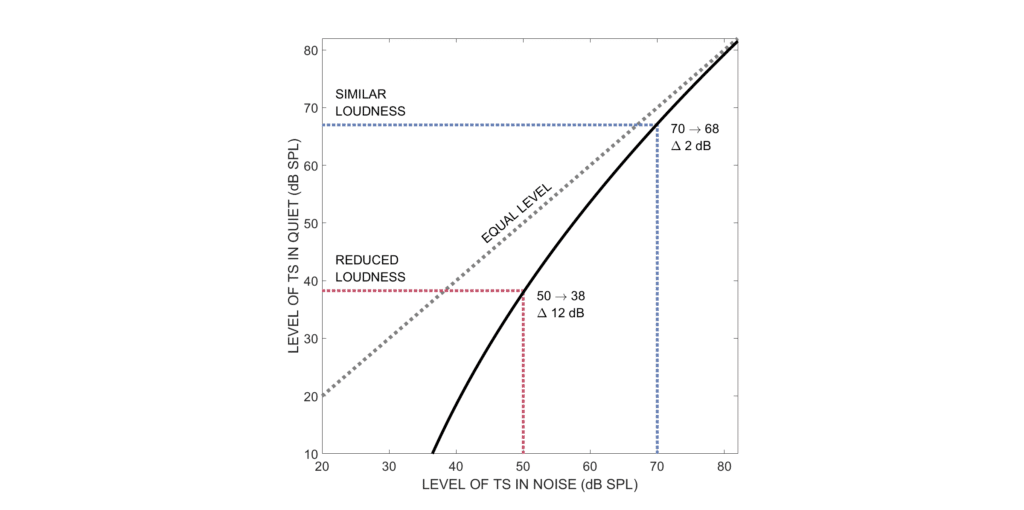
Notably, the loudness-matching function becomes less steep as the level of the masking noise is reduced. For example, Figure 2 shows how the slope of the loudness-matching function is shallower for a background noise of 40 dB SPL relative to 60 dB SPL. In this case, a TS presented at 65 dB SPL in a background noise of 60 dB SPL (i.e., SNR = 5 dB) would be perceived as equally loud as a TS presented at ~42 dB SPL in quiet. However, at the same fixed SNR of 5 dB, a TS presented at 45 dB SPL in a background noise of 40 dB SPL would be perceived as equally loud to a TS presented at ~29 dB SPL in quiet. So, while the level of noise is reduced by ΔL = 20 dB (from 60 to 40 dB SPL), the loudness of the TS only drops by ΔL ≈ 13 dB (from 42 to 29 dB SPL). In other words, the loudness of a TS heard in noise is less impacted by partial loudness effects at lower levels of masking noise than at higher levels of masking noise. This suggests that carefully lowering the noise level, in a manner that still ensures audibility of the TS, could be used to enhance the perceptual magnitude of the TS relative to the background without modifying the actual acoustic SNR.
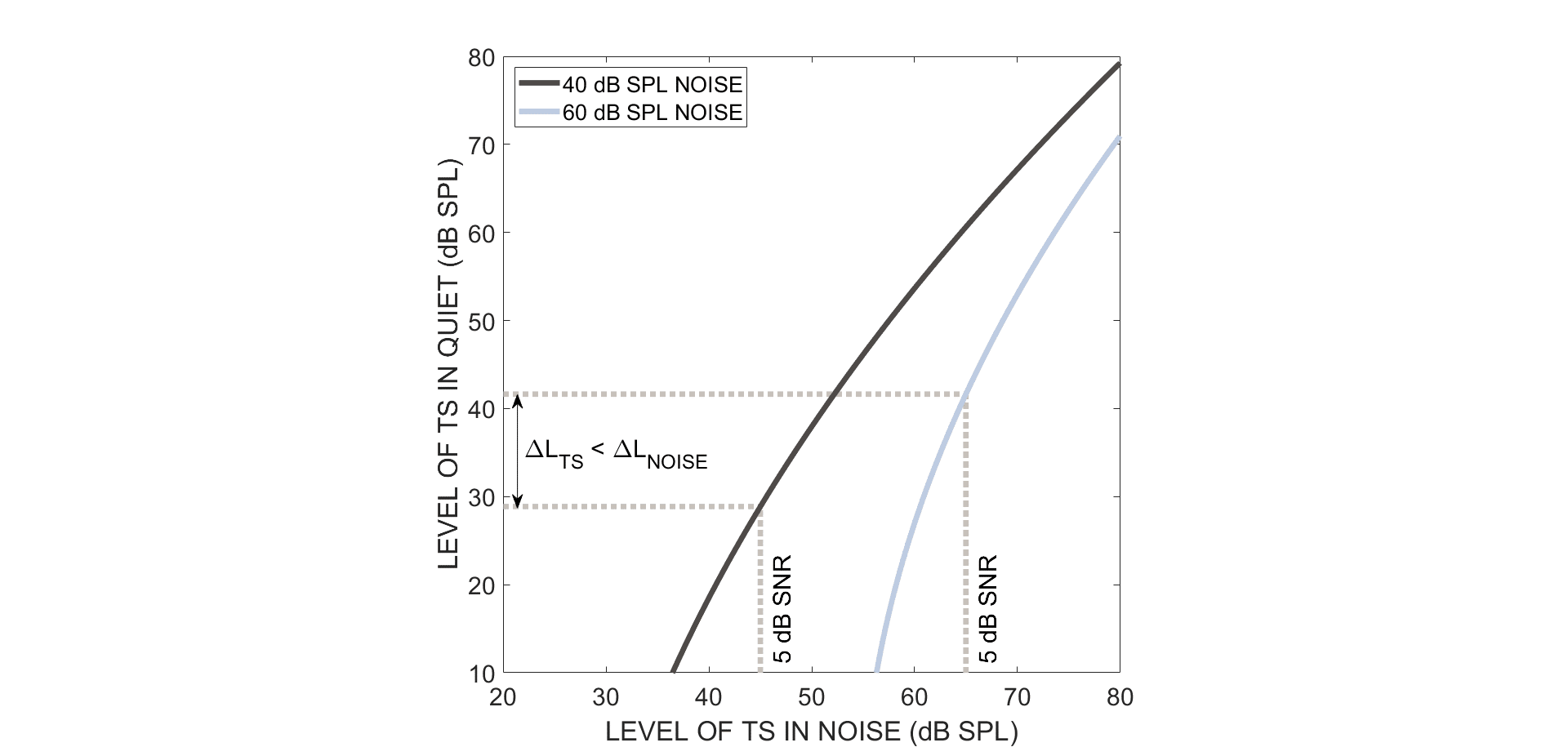
Loudness and Hearing Loss
Listeners with hearing loss (HL) may be particularly sensitive to partial loudness effects in lower background noise levels because of how their loudness growth functions differ from those of listeners with normal hearing (NH). Specifically, the slopes of loudness growth functions—which describe changes in loudness as a function of input SPLs—tend to be steeper in listeners with HL than with NH, especially at and above threshold levels (Figure 3). The growth of loudness near threshold is very fast, with loudness diminishing rapidly as sound levels lower to near or below threshold levels. Thus, small adjustments in a sound’s level around the threshold of a listener with HL can have large impact on how that listener perceives the sound’s loudness. Hence, lowering the noise level to near a listener’s threshold should limit the impact of partial loudness on the TS, i.e., making the TS appear louder.
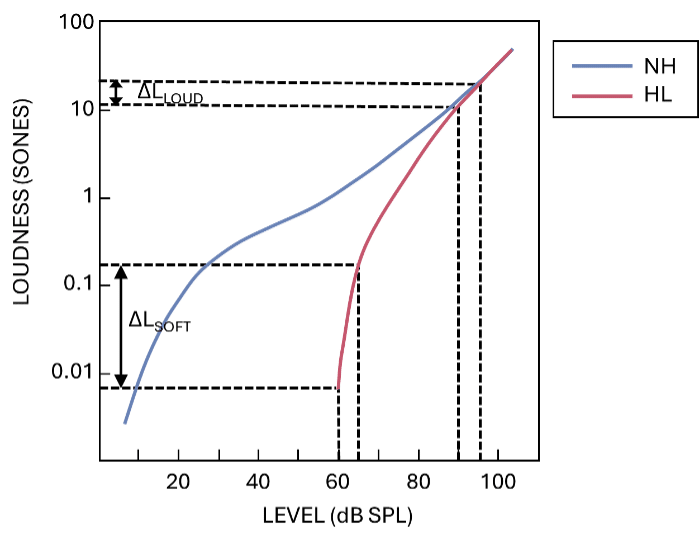
Placement of Aided Sound Dynamics
To provide the full dynamic range of an input sound to the hearing aid wearer, the range of output from the hearing aid should be placed such that sounds from the softest to the loudest are audible at all frequencies. The bottom or the lower end of the output range is referred to as the aided noise floor. If the aided noise floor is placed above the hearing threshold level of the listener, even the softest sounds should be audible (Figure 4, red curve). On the other hand, in the presence of background noise, we may reduce the audibility of the noise by placing the aided noise floor below the hearing aid wearer’s threshold (Figure 4, gray curve). By placing the noise floor just below the hearing threshold and speech just above the hearing threshold, we could ensure audibility of the TS while lessening the impact of noise to result in a louder perception of the TS.
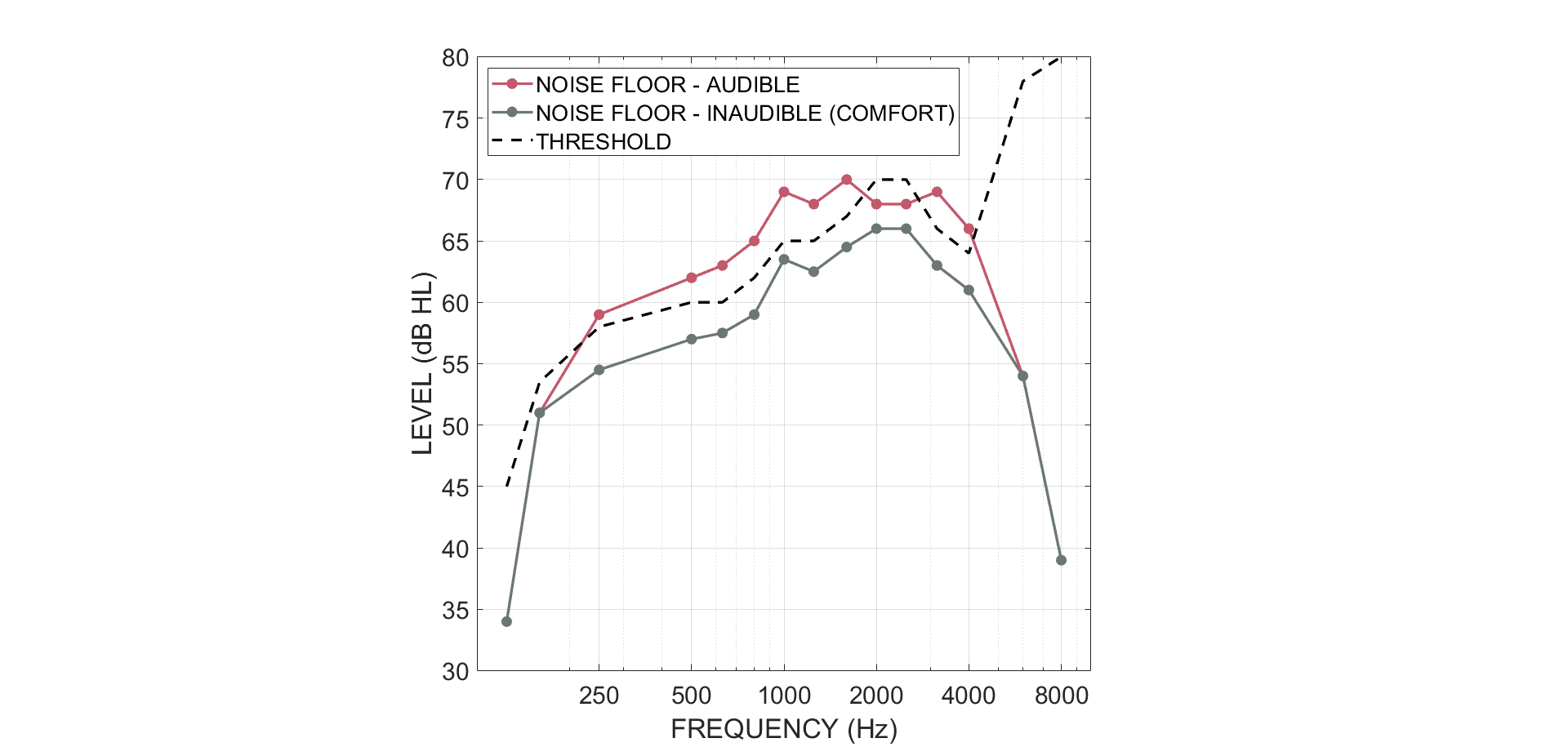
Optimized Hearing Aid Output
Modern hearing aids include several signal processing algorithms that alter the gain based on the acoustic characteristics of the input signal at each frequency band to improve the audibility of target sounds and to lessen the negative impact of undesirable background sounds. Some algorithms, such as wide dynamic range compression (WDRC), noise reduction, directional microphones, and feedback management may decrease the gain selectively for unwanted sounds or sounds that are too loud, or they may increase the gain for desired sounds. As more features operate simultaneously in a hearing aid, it becomes increasingly challenging to control where the final hearing aid output level is placed relative to the user’s hearing loss. The Speech Enhancer Pro (SEPro) with Hearing Threshold Level Optimizer (HTL Opt) feature implemented in Widex Allure hearing aids was designed to optimally place the final hearing aid output dynamic range relative to the wearer’s hearing loss.
The HTL Opt strategically controls the location of the aided noise floor relative to the individual hearing threshold at each frequency band. In frequency bands with little noise, HTL Opt provides the listener with the whole dynamic range of the signal, while in frequency bands with noise, HTL Opt places the aided noise floor below the wearer’s hearing threshold. HTL Opt is unique in that it considers the gain from other noise reduction algorithms and the compressor and operates as the final optimizer at the end of the sound processing chain before sound is delivered to the hearing aid wearer. Thus, the combined effect of all features on the overall sound can be optimized with precision at each frequency band based on the individual’s hearing loss.
Perceptual Consequences
Placing the aided noise floor at or slightly below the hearing aid wearers’ threshold using the HTL Opt feature leads to a decrease in perceived overall loudness. However, the partial loudness principle that we described earlier would suggest that the decrease in loudness is experienced more for the noise than for the TS. In other words, under noisy conditions, the TS should be perceived as louder with the HTL Opt (HTL Opt-ON) than without the HTL Opt (HTL Opt-OFF). In the present study, we wanted to validate this speculation by having hearing aid wearers match the loudness of natural speech targets, presented in quiet versus in the presence of a broadband background masker, while wearing a prototype version of the new Widex Allure hearing aid that allowed for testing with and without the HTL Opt feature enabled. We predicted that the action of the HTL Opt would optimize the level of noise at the HA output and in return increase the partial loudness of the TS in noise such that listeners would set the level of the TS in noise to be closer to that of the TS in quiet.
METHODS
Participants
Ten listeners (mean age = 72.5 years, range = 40-89 years, 4 females) with bilaterally symmetrical sensorineural hearing loss participated. Their four-frequency pure-tone averages (4PTAs) across two ears was 56.9 dB HL. Nine listeners were experienced HA wearers (average years of use = 19.4 years). All listeners were native English speakers, and their scores on the Montreal Cognitive Assessment (MoCA) were ≥ 23 of 30 [7].
Hearing Aids and Fitting
Listeners were tested using a prototype version of Widex Allure 440 receiver-in-the-canal (RIC) hearing aids (HAs) programmed with the Compass Cloud software. Hearing aid gains were matched to NAL-NL2 fitting targets. These HAs include variable speed compression (VSC) technology, which was designed to retain the temporal envelope dynamics of input signals, while providing extra audibility for soft sounds in quiet [8].
The SEPro noise reduction system consists of three elements. The first element classifies the input signal into signal and noise across 52 analysis bands and reduces the gain in channels containing noise by an amount determined based on the input level, speech-to-noise ratio, and frequency importance of the channel. The second part of the system adjusts the gain (decrease or increase) to maximize the speech intelligibility index (SII) of speech for the individual listener in the specific noise background.
The third element of the system is the HTL Opt feature, which is an individualized noise reduction algorithm targeted specifically at hearing thresholds above 40 dB HL. It optimizes the final hearing aid output in each frequency channel after all other advanced processing (compression, directionality etc.) has been applied. HTL Opt considers the listener’s audiogram and places the noise floor optimally to just below the listener’s hearing threshold but not so much as to under-amplify the target sounds. In the study, two settings were used, HTL Opt-OFF and HTL Opt-ON, the latter allowing approximately 3 dB of overall gain reduction in the final output. The environmental classifier was disabled, and the hearing aid was in an omnidirectional microphone mode.
Stimuli
We asked listeners to compare the difference in loudness between the target sound in quiet (TS-Q) and target sound in noise (TS-N) as presented while in HTL Opt-ON or HTL Opt-OFF conditions. Measurement of level differences between TS-Q and TS-N shows the negative impact of noise on TS loudness. The TS was a two-minute-long passage spoken by a male talker. The background noise was a continuous noise with a spectrum that matched the target speech passage. When presented in quiet, the level of the TS was 65 dB SPL. When presented in a fixed 75 dB SPL noise, the level of the TS varied based on the listener’s responses. Stimuli were presented through a loudspeaker placed 1 meter in front of the listener.
Procedure
Loudness matching was conducted using a two-alternative forced-choice task. The TS-Q and TS-N intervals were presented alternately each for 3 seconds. The TS-Q interval was always presented first followed by the TS-N interval. Participants were asked to indicate the interval in which the TS was louder by pressing the appropriate button on a monitor.
The level of the TS in noise was adaptively varied based on the participant’s responses using a staircase method. The objective was to set the level of the TS-N so it was perceived as equally loud as the TS-Q. Initially the TS was 10 dB louder in noise than in quiet. The step-size for the TS level change was initially set at 8 dB, then 4 dB after two reversals, 2 dB after four reversals, and 1 dB after six reversals. The test terminated after a total of 16 reversals. The difference in the TS level between quiet and noise was calculated from the last 8 reversals. This value indicates the level that the TS-N needed to be increased to be perceived as equally loud to the TS-Q. Indirectly, this measurement reflects the amount of attenuation that the noise has on the loudness of TS.
RESULTS
Changes in loudness of the TS in the presence of noise with HTL Opt-OFF and HTL Opt-ON are shown in Figure 5. Data points above the parity line indicate less TS level adjustment (i.e., smaller noise impact or TS perceived as louder) in the HTL Opt-ON than in the HTL Opt-OFF condition. Because this figure shows that all the data points are above the parity line, it suggests that all listeners adjusted the speech level less in the HTL Opt-ON condition compared to the HTL Opt-OFF condition to achieve equal loudness between TS-N and TS-Q. A paired-samples t-test confirmed that there was a significant difference in the TS level adjustment for HTL Opt-ON (mean = 3.8 dB, SD = 2.4 dB) and HTL Opt-OFF (mean = 4.8 dB, SD = 2.1 dB) conditions (t(9) = 4.911, p < 0.001).
These results show that the same TS level is generally perceived as louder in the HTL Opt-ON condition than in the HTL Opt-OFF condition. Thus, the action of the HTL Opt improves the “perceptual” SNR by increasing the contrast between the auditory foreground (i.e., TS) and the background (i.e., noise), making it easier for listeners to group speech features into coherent auditory objects and put them into meaningful streams of information. Anecdotally, some of our research participants reported that speech “pops out” from the noise background with HTL Opt activated.
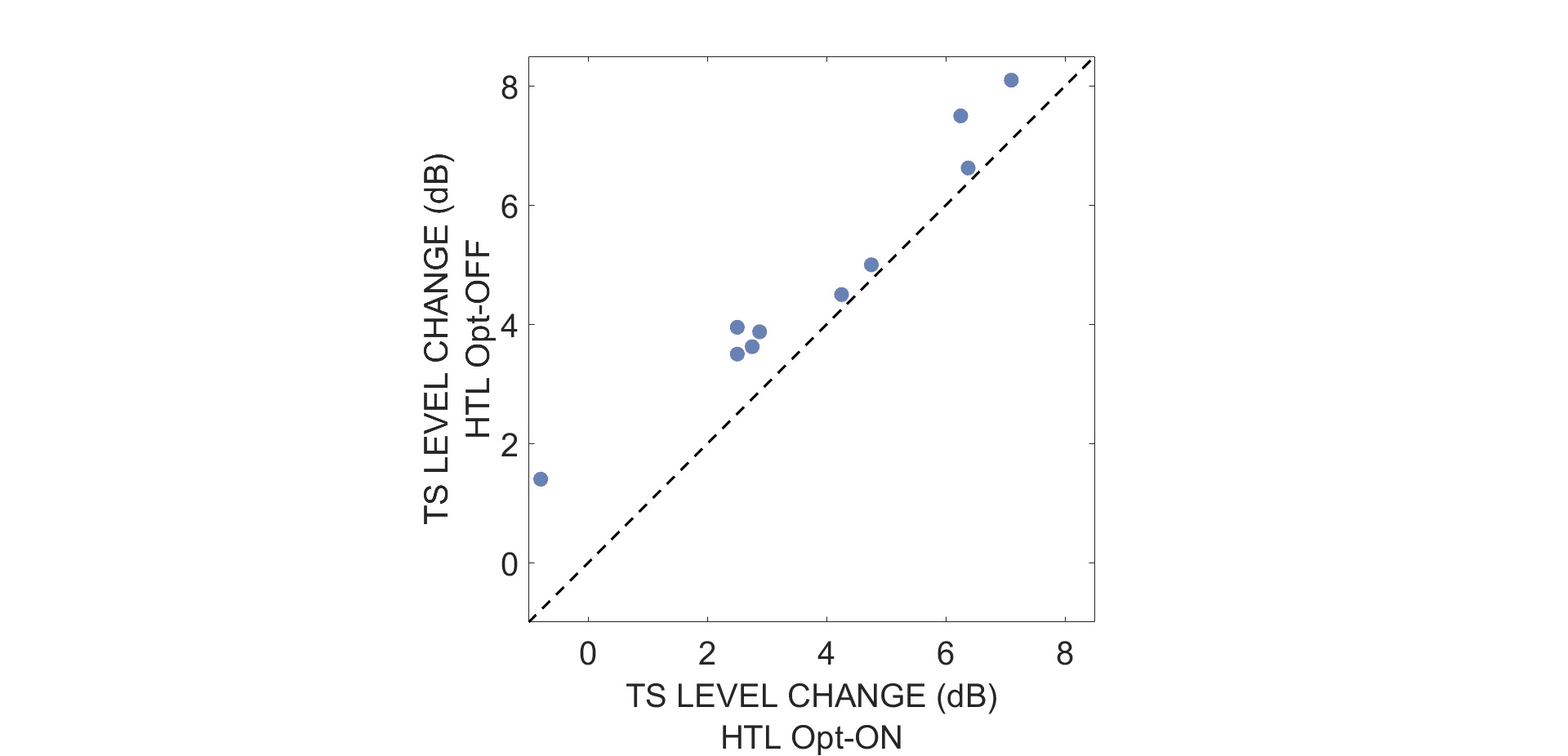
DISCUSSION
This study showed that lowering the aided noise floor of the hearing aid output in a controlled manner, as implemented by HTL Opt in the SEPro feature, results in better preservation of speech loudness when listening to speech in noise. The real-life benefit of this feature is that speech loudness would be more similar across more noisy conditions, improving the perceived naturalness of the target speech sounds.
When noise makes it difficult to hear speech, hearing aid wearers will intuitively increase the volume (or output) of their hearing aids. The volume increase will elevate the level of speech and noise by an equal amount. Because the impact of noise on target speech loudness is greater at higher noise levels, increasing the overall level may have the unintended (and unintuitive) negative consequence of reducing the loudness of speech. While reducing the overall volume could reduce the masking effect, it could also render some useful speech information inaudible. By taking advantage of the partial loudness phenomenon and considering the wearer’s thresholds and the presence/absence of noise in each frequency region, the SEPro on the Widex Allure platform can strategically lower the final overall output while ensuring that the audibility of the softer speech components is not affected.
The results of the current study urge caution when interpreting and acting to resolve hearing aid wearers’ comments about their hearing aids not being loud enough (or too loud). Loudness depends on the listening context. Listeners may direct their attention to different sounds in their environment based on their needs. They may focus on the loudness of an individual sound (e.g., a single talker), on a set of sounds (e.g., all the talkers around a table in a restaurant), or on the entire auditory experience (e.g., all the sounds in the restaurant including background noises). When listeners state that their hearing aids are not loud enough, clinicians must follow up with specific questions to identify the contexts and the intended target sounds for a more precise solution. If the entire auditory experience is too soft (or too loud), adjusting the overall hearing aid output is a reasonable solution. On the other hand, when the target speech in noise is not loud or clear enough, as was the setup in the current study, the solution is not to raise the overall output level of the hearing aid but to reduce the output level of the noise with precision to an optimal level relative to the wearer’s hearing thresholds. Such adaptive frequency-dependent adjustment involves constant monitoring of the hearing aid output and can only be achieved with a dedicated algorithm such as the Speech Enhancer Pro with Hearing Threshold Level Optimizer.
About the Authors:
Petri Korhonen, MSc (tech), is a principal research scientist; Francis Kuk, PhD, is the director; Christopher Slugocki, PhD, is a senior research scientist; and Heidi Peeters, MA, is a research audiologist at the WS Audiology Office of Research in Clinical Amplification (ORCA) in Lisle, Ill.
References
1. Korhonen P, Slugocki C, Kuk F, Peeters H. Impact of Hearing Aid Processing Delay on Stop Consonant Voicing Perception in Open Fittings. Am J Audiol. 2024;33(3):932-941. doi:10.1044/2024_AJA-24-00034
2. Scharf B. Partial masking. Acta Acustica united with Acustica, 1964. 14(1):16-23.
3. Moore BC. Development and current status of the “Cambridge” loudness models. Trends Hear. 2014;18:2331216514550620. Published 2014 Oct 13. doi:10.1177/2331216514550620
4. Marozeau J, Florentine M. Loudness growth in individual listeners with hearing losses: a review. J Acoust Soc Am. 2007;122(3):EL81. doi:10.1121/1.2761924
5. Buus S, Florentine M. Growth of loudness in listeners with cochlear hearing losses: recruitment reconsidered. J Assoc Res Otolaryngol. 2002;3(2):120-139. doi:10.1007/s101620010084
6. Studebaker GA, Sherbecoe RL, McDaniel DM, Gwaltney CA. Monosyllabic word recognition at higher-than-normal speech and noise levels. J Acoust Soc Am. 1999;105(4):2431-2444. doi:10.1121/1.426848
7. Nasreddine ZS, Phillips NA, Bédirian V, et al. The Montreal Cognitive Assessment, MoCA: a brief screening tool for mild cognitive impairment. J Am Geriatr Soc. 2005;53(4):695-699. doi:10.1111/j.1532-5415.2005.53221.x
8. Kuk F, Slugocki C, Korhonen P, Seper E, Hau O. Evaluation of the Efficacy of a Dual Variable Speed Compressor over a Single Fixed Speed Compressor. J Am Acad Audiol. 2019;30(7):590-606. doi:10.3766/jaaa.17127


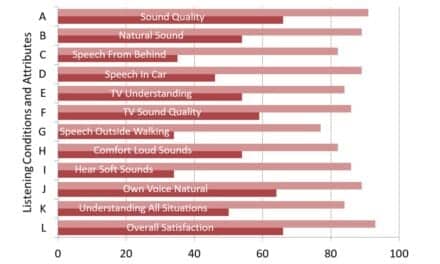


Such nuanced insight into the subjectives of hearing, and sheer genius in getting algos to interface with the dynamics of individual hearing leads to a longing for perception of MUSIC to be awarded such treatment!
An early career in sound (BBC), when my hearing hadn’t yet drooped into old age, taught me that even the simplest wideband programme compressor could make a mess of music: makes varied greatly. Indeed the BBC was among the first to devise look-ahead, achieved in analogue, to obviate transient spikes that could greatly disturb transmitters.
Interestingly, talking of subjectivity, the pop channel DJs didn’t like it because of the lack of gritty urgency that bad compression delivers! Classical concerts benefited, even though the primitive programme dependent recovery delivered odd emphasis and fade-ups on quiet passages.
Hey, keep researching!